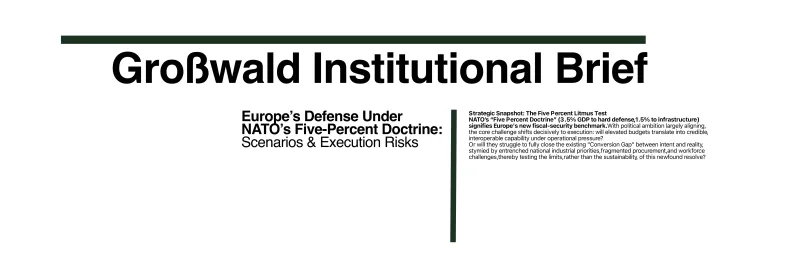Iran’s Missile Ecosystem and Strategic Outreach: From Regional Escalation to Eurasian Relevance

Introduction
Iran’s missile programs have long been a regional concern—but their growing reach, precision, and geopolitical deployment now raise broader questions for NATO’s eastern flank and strategic deterrence. The October 2024 missile strike on Israel, featuring hypersonic systems and solid-fuel precision munitions, marked a new phase in Iran’s strategic signaling. Yet more consequential is Tehran’s expanding export of missile systems and expertise—particularly to Russia in the context of the war in Ukraine.
This Großwald brief synthesizes key developments across Iran’s missile ecosystem, examining:
- The operational patterns of its regional use
- The flow of systems to sanctioned partners like Russia
- The doctrinal implications for Europe’s integrated air and missile defense (IAMD)
October 2024: Iran’s Missile Strike on Israel and Hypersonic Escalation
On October 1, 2024, Iran launched a coordinated missile attack against Israeli targets, involving approximately 180 missiles. Among them were:
- Fattah-1 hypersonic missiles
- Solid-fuel Fateh-class ballistic missiles (e.g., Fateh-110, Haj Qasem)
- Liquid-fuel legacy systems (Emad, Badr, Khorramshahr)
Iran claimed that 90% of its missiles hit designated targets. While the U.S. and Israel downplayed the strike’s operational impact, analysts noted a strategic objective: testing and degrading Israeli missile defenses such as Iron Dome, David’s Sling, and Arrow.
Key tactical features:
- Solid-fuel maneuverable re-entry vehicles (MaRVs) enabled course correction and evasive behavior
- Saturation strategy through missile-type mixing—designed to overwhelm layered defense systems
Though framed as retaliation for Israeli operations in Gaza and Lebanon, the strike also demonstrated Iran’s ability to orchestrate a multi-theater attack using a precision-guided inventory, backed by real-time ISR and strategic timing.
Strategic Spillover: Iran–Russia Missile Transfers and the Ukraine War
The regional use of ballistic systems is no longer Iran’s limit. Since early 2024, multiple intelligence sources have confirmed:
- Transfers of Fateh-110 and Zolfaghar SRBMs to Russia
- Joint training programs for Russian operators in Iran
- Technology sharing involving guidance systems and launch logistics
These missile types, with ranges between 300 and 700 km, have been observed in strikes against Ukrainian infrastructure. While Tehran publicly denies involvement, visual evidence, satellite telemetry, and intercepted communications support the conclusion of operational Iranian-Russian cooperation.
U.S. and EU sanctions in response have targeted:
- Iran’s Aerospace Industries Organization (AIO)
- IRGC-linked tech exporters
- Dual-use shipment routes through the Caspian Sea and the Persian Gulf
Missile Proliferation through Proxy Networks
Beyond state-to-state transfers, Iran continues to supply:
- Hezbollah with 150,000+ rockets and GPS-guided munitions
- The Houthis with cruise missiles and drones used in attacks on Tel Aviv (July 2024) and maritime shipping in the Red Sea
- Hamas with Iranian-designed rockets and engineering assistance
This “horizontal escalation” model enables Tehran to exert pressure through non-state actors while denying direct attribution. It also stretches adversary missile defense postures thin, forcing states like Israel and Saudi Arabia to maintain multiple, expensive interception layers.
Technology Pipeline: North Korean Influence and IRGC Space-Missile Convergence
Iran’s hypersonic and solid-fuel systems have been shaped by years of cooperation with North Korea. Shared technologies include:
- Solid propellant formulations for SRBMs
- Guidance and telemetry systems adapted for mobile launchers
- Designs for MaRVs (maneuverable warheads) capable of evading interceptors
Parallel to its terrestrial missile force, Iran is accelerating its space program under the IRGC Aerospace Command:
- Simorgh and Qased launch systems have successfully placed satellites into LEO
- Upcoming test flights involve all-solid-fuel satellite launch vehicles (SLVs)—raising concerns of covert ICBM development
- Underground silo infrastructure is expanding, complicating early warning and preemptive targeting
This convergence of missile and space programs creates a strategic ambiguity that complicates arms control and defense planning, especially as Iran moves closer to dual-use breakout potential without a declared nuclear capability.
NATO IAMD and Europe’s Strategic Exposure
While Iran’s missiles are regionally deployed, their doctrinal and operational features are globally relevant—particularly for Europe’s evolving missile defense architecture.
Emerging European Vulnerabilities:
- Deployed assets in the eastern Mediterranean (e.g., French and Italian naval presence)
- Forward-operating U.S. and NATO bases within range of Iran’s extended-reach platforms
- Critical energy infrastructure in southern Europe susceptible to proxy disruption (e.g., via Houthis or cyber-enabled strike coordination)
NATO’s Response:
- Aegis Ashore systems in Romania and Poland
- THAAD and Patriot redeployments during high-risk periods
- Bundeswehr participation in European Sky Shield Initiative (ESSI) to enhance pan-European IAMD interoperability
The Bundeswehr’s doctrinal pivot toward Multi-Domain Operations (MDO) and OpArch FühFa Bw (Operational Architecture Leadership Capability) explicitly recognizes the growing complexity of air and missile threats—not only from peer adversaries like Russia, but from regional accelerants like Iran.
Conclusion:
Iran’s missile program is no longer a purely regional threat. It is a strategic force multiplier, exported through proxies, transferred to partner states like Russia, and backed by a growing technological base that spans hypersonics, solid fuels, and satellite-enabling infrastructure.
For NATO and Germany, this underscores the urgency of:
- Sustained investment in IAMD systems
- Intelligence fusion and cross-theater threat mapping
- Monitoring missile–space convergence trends, especially in states with asymmetric warfare doctrines
Iran's arsenal is not yet directed at Europe—but the architecture it enables, and the adversaries it arms, are already reshaping Europe’s strategic perimeter.
Structured Intelligence Series | Großwald.org
Related briefs:
• Integrated Air & Missile Defense: Multilayer Architecture from SHORAD to Strategic Shielding




